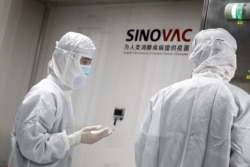Myanmar’s coup leader, Senior General Min Aung Hlaing, is aiming for 50% of country’s population to be vaccinated against COVID-19 by the end of this year, but there are difficulties and obstacles on the ground to achieving that goal.
Since July 28, the State Administration Council, which overthrew democratically elected government led by the National League for Democracy, has been administering vaccinations, using the Chinese-made Sinopharm and Sinovac vaccines, across the country.
From July to August 8, Beijing sent 4.5 million doses to Myanmar, including 2.5 million donated Sinopharm doses and 2 million Sinovac vaccines purchased by the military. Two million more doses will be arriving this month, as the military purchased a total of 4 million Sinovac doses.
The Health and Sports Ministry started its vaccination program in the last week of July. Medical workers, volunteers, prisoners and those above 65 years old are in the priority group to be vaccinated. The state newspaper The New Light of Myanmar reported August 6 that more than 1.8 million people, 6.08% of the targeted population, had been vaccinated.
Myanmar has more than 30 million people over the age of 18 to be vaccinated, 50% of whom, 17 million people, are targeted to be vaccinated at the end of this year, Health and Sports Ministry spokesman Dr. Than Naing Soe told VOA.
“To vaccinate 50% of the total population at the end of this year, we need to vaccinate 5 million people a month,” Min Aung Hlaing said at an August 2 meeting.
Amid this uncertain situation, Than Naing Soe recently told VOA that the government is confident it will meet the target. The SAC is planning to receive vaccines from China, India, Russia, and international and regional organizations.
Two million doses purchased from Russia will arrive in coming months and efforts are being made to obtain the remaining vaccines from India. Under the previous NLD government, Myanmar purchased 30 million doses from India and has already paid $75 million, half of the initial order value. It had received 2 million Indian Covishield doses in January.
“Now we are giving about 150,000 injections per day. There is no issue with receiving vaccine yet. If the situation is better than this, at the end of this year, we can reach 70% of the targeted population,” Than Naing Soe told VOA August 9.
According to the ministry, 1.8 million people were vaccinated between January 27 and July 21, using 3.5 million vaccines from India -- 1.5 million donated and 2 million purchased -- and 300,000 Sinovac doses from China.
China vaccinating armed groups on the border
China is helping to vaccinate ethnic armed groups in areas bordering China to prevent the spread of the delta virus through Myanmar.
Since April, 40,000 people have been vaccinated using Sinovac doses in areas of the northern Kachin state controlled by the Kachin Independence Organization, one such ethnic group. Of those doses sent to Kachin, 99% were arranged by the Chinese government through Red Cross organizations in neighboring Yunnan province, and 1% were purchased by the KIO, Colonel Naw Bu, a KIO spokesperson told VOA August 9. However, the vaccination program has been suspended since July 30 after new positive cases were found. Naw Bu said the vaccination program will be resumed in the coming week, targeting another 50,000.
“We will try and get more shots depending on the availability of the vaccine from China," Naw Bu said.
The United Wa State Army, the most powerful of the ethnic armed groups, based in eastern Shan state, has managed to get vaccine to almost all its nearly 500,000 population, said Nyi Rang, a liaison officer in Lashio, in Shan state. He refused to give further information such as the kind of vaccine or who provided it.
According to unconfirmed reports, the COVID-19 vaccine given in the Wa region of Shan state is Chinese-made Sinovac, which is being used in areas controlled by the Kachin Independence Army, the armed wing of the KIO, and other ethnic armed groups.
China is not only providing vaccine in areas controlled by ethnic armed groups but is also negotiating with authorities of states and regions to provide vaccines for residents living along the border, according to Than Naing Soe.
"Negotiations are underway. The details of the plan will be released after the talks,” he told VOA.
Lack of trust
Public opinions on the military’s vaccination program and Chinese vaccine differ. Some see getting Chinese vaccination is better than nothing. Some say they would not be vaccinated to boycott military council's immunization program.
In addition, anti-Chinese sentiment has been high in Myanmar since the coup, as China has shown support for the military council.
A 78-year-old retired military officer, Myint Lwin, had the chance to be vaccinated in March. He did not take it, though, because of distrust of the Chinese vaccine.
“Now the death toll is much higher. I feel it is safer to be vaccinated than nothing,” Myint Lwin said. He got the Sinovac vaccine on August 4.
Many others feel the same way – they distrusted the vaccine before but are now willing to take it, with Myanmar’s death toll having hit 12,234 as of August 10. The death toll does not list those who died at home and it is expected that the actual death rate would be three times that announced by the military.
Thirty-eight-year-old Mo Mo, who asked to be identified by only part of her name and who runs a restaurant in Yangon, told VOA she would not be vaccinated with Chinese vaccines under the military council's immunization program.
“My family does not recognize the military regime. So, we have no reason to deal with them,” she said. The second reason, she said, is that they do not believe in the effectiveness of the Chinese vaccine.
“I have heard we will be able to get the Indian vaccine at the private hospitals very soon. Until we get that vaccine, we have to take care of ourselves by wearing double masks, taking antibiotics, washing our hands and staying at home,” Mo Mo said.
It appears that the military regime has not been able to convince the public to participate in its immunization plan. Some do not trust the military, some reportedly fear the military will try to kill them with the injections, directly or through later side effects. The situation is made worse by a shortage of health workers.
To fill the gap, the junta has asked health staff on strike in opposition to the coup to join the fight against the pandemic, although the military keeps targeting and arresting heath workers who are members of the opposition Civil Disobedience Movement.
"No one will return to the hospitals under such horrifying conditions," a CDM physician who used to work for the general hospital in the Mandalay region and who requested anonymity told VOA recently.
He refused to comment on whether public should take vaccines, which he said is an individual matter.
"It would be best if 50% of population were vaccinated at the end of the year. But it will not succeed without public cooperation” he added.








